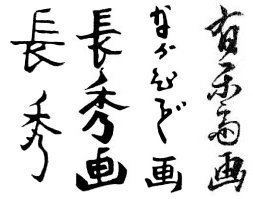 | ||
Urakusai Nagahide (Japanese: 有楽斎 長秀), was a designer of ukiyo-e style Japanese woodblock prints who was active from about 1804 to about 1848. He is also known as Yūrakusai Nagahide (有楽斎 長秀), Nakamura Nagahide (中邑 長秀 or 中村 長秀), Chōshū (長秀), and as Chōshūsai (長秀斎). “Nagahide” and “Chōshū” are written with the same kanji. The ending “sai” means studio or hall, and is added or omitted at will by many Japanese artists.
Nagahide worked in both Kyoto and Osaka. His early prints resemble those of his teacher Ryūkōsai Jokei, but were also influenced by Shōkōsai Hanbei. Such a radical change occurred in Nagahide’s style that some scholars believe that the body of works signed “Nagahide” may actually have been created by two different artists. From the 1810s to the 1830s, Nagahide was the most prolific designer of stencil prints (kappazuri) depicting the annual costume parade in the Gion district of Kyoto, and he continued producing kappazuri long after full-color woodblock prints (nishiki-e) had become the standard for Japanese woodblock prints. His students include Nagashige, Hidekatsu, Hidekuni, Hidemari, and Naniwa Nagakuni.
